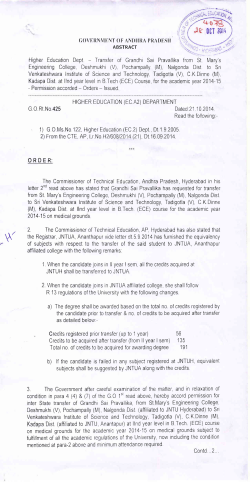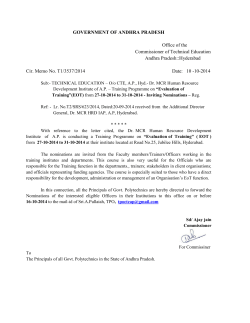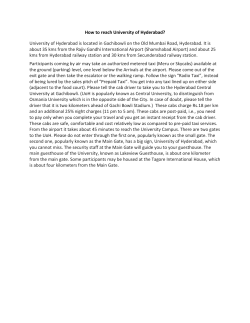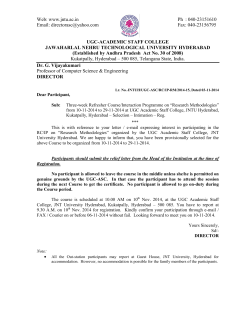
FIERY ICE 2014 9 International Methane Hydrate R&D (IMHRD) Workshop
Geological Field Excursion Guide Hyderabad to Nagarjuna Sagar (November 9, 2014) FIERY ICE 2014 9th International Methane Hydrate R&D (IMHRD) Workshop Organized by CSIR-National Geophysical Research Institute 1 2 COMMITTEES Fiery Ice International Steering Committee • Richard B. Coffin,Department of Physical and Environmental Sciences, Texas A&M University -Corpus Christi, USA • Bjørn Kvamme,Department of Physics and Technology, University of Bergen, Norway • Stephen M. Masutani,Natural Energy Institute,University of Hawaii, Honolulu, USA • Hideo Narita,National Institute of Advanced Industrial Science and Technology,Sapporo, Japan • Tsutomu Uchida,Division of Applied Physics, Faculty of Engineering, Hokkaido University, Japan Local Advisory/Organizing Committee • Prof. Harsh K. Gupta, Atomic Energy Regulatory Board (AERB), Mumbai , Chair • Dr. Shailesh Nayak, Ministry of Earth Sciences, New Delhi • Shri B. N. Talukdar, Directorate General of Hydrocarbons, Noida • Dr. S.K. Srivastava, Oil India Limited, Dhuliajan • Dr. Y.J. Bhaskar Rao, CSIR-National Geophysical Research Institute, Hyderabad • Dr. S.W.A. Naqvi, Director, CSIR-National Institute of Oceanography, Goa • Dr. M.A. Atmanand, National Institute of Ocean Technology, Chennai • Dr. S. Rajan, National Centre for Antarctic & Ocean Research, Goa • Dr. Pushpendra Kumar, Gas Hydrates KDM Institute of Petroleum Exploration, ONGC, Dehradun • Dr. Kalachand Sain, CSIR-National Geophysical Research Institute, Hyderabad, Convener Convener Dr. Kalachand Sain CSIR-National Geophysical Research Institute Gas-hydrate Group, Uppal Road, Hyderabad - 500 007, India E-mail: [email protected] Ph No. +91 040-2701 2799 (O) Mob: +91 9440964038 Website: http://www.fieryice2014.org/ 3 Background The growing demand of energy and depletion of fossil fuels necessitate looking for an alternate source for sustainable development. Among various forms of renewable and unconventional energy resources, gas hydrates seem to be the major unconventional energy resource for the next generation because of their abundant occurrences in nature. The energy potential of gas hydrates is so huge that even 15% production from global reserve can meet the world’s energy requirement for about two hundred years. Successful production tests through carbon dioxide replacement method in the permafrost of Alaska (USA) in 2012 and by depressurization method in the Nankai Trough off Japan in 2013 have increased tremendous interests to the national gas hydrates programs of many countries, particularly in the Asian countries. It is expected that gas hydrates will be produced commercially by another 10 years times. The ’Fiery Ice’ International Methane Hydrates R&D (IMHRD) Workshops were earlier held in Honolulu, Hawaii; Washington DC; Vina del Mar, Chile; Victoria, British Columbia; Edinburgh, Scotland; Bergen, Norway; Wellington, New Zealand; and Sapporo, Japan. The 9th IMHRD Workshop will be held in Hyderabad, India during November 9-12, 2014 that will provide a platform for deliberation, interaction and sharing information on new advances of several perspectives of gas hydrates. The leading edge topics covering the natural systems, energy, environmental impacts, flow assurance, advancement in production technology, etc will be presented and discussed by an outstanding and diverse group of scientists (academic and industries) from different countries, fostering an opportunity for International collaboration. 4 Structure of the Workshop • • • • • • • • 1-day pre-workshop ‘Geologic Field Excursion’ on November 9, 2014, as a part of the Workshop Inaugural and Plenary sessions 2 Key-note presentations 10 National Reports on recent progress of gas hydrates R&D in respective countries. 15 oral presentations on latest work of gas hydrates 25 posters on cutting-edge R&D on gas hydrates. Theme-wise ‘break-out sessions’ spread during the workshop 1-day Post-Workshop ‘Seminar on Indian Gas Hydrates’ or ‘Laboratory visit to NGRI’ Nagarjuna Sagar Field Excursion, Time Schedule November 9, 2014 • • • • • • • • • • 07:00 hrs: 09:00 hrs: Departure: CSIR-NGRI guest House Breakfast at the Geological field stop no. 1 09:30 – 10.30 hrs Geological field Stop 2 12.00 hrs: Geological field Stop 3 13:00 – 14:00 hrs: Lunch at Vijaya Vihar Guest House, APTDC 14.00 – 15.30 hrs: Visit to Cultural site 16:00 hrs: Geological field site stop no. 4 16:30 hrs: Evening Snacks 17:30 hrs: Tea at Devarakonda X’roads 20:00 hrs: Return to the Hotel 5 Preface One day geologic field excursion on November 9, 2014, organized as a part of the 9th International Methane Hydrate R&D (IMHRD) Workshop provides glimpse of the Archaean greenstone belts, Precambrian granites and gneisses, and Proterozoic sediments in the Eastern Dharwar Craton. The participants also will visit one of the largest (masonry) irrigation dams in Asia. The geological excursion to Nagarjuna Sagar from Hyderabad is planned exclusively for the delegates of IMHRD. The objectives of this excursion are two fold: (1) offers glimpse of the Precambrian geology of the Eastern Dharwar Craton and (2) experience the environs of the Nagarjuna Sagar reservoir - a major multipurpose irrigation project. The following pages present a brief introduction to the geologic setting and a description of four interesting geologic outcrops (scheduled stops) along the 150 km-long traverse. November 9, 2014 6 E.V.S.S.K. Babu T. Vijaya Kumar T.R.K. Chetty & Kalachand Sain Geological Field Excursion Guide Hyderabad to Nagarjuna Sagar (A late Archaean to Mesoproterozoic geologic cross section in the Eastern Dharwar Craton) Field traverse and the locations of the outcrops 7 Regional Geology Much of the Indian Peninsula is made-up of Precambrian formations which include: Archean cratons, Proterozoic mobile belts and Proterozoic supracrustal sedimentary basins (Fig. 1). The southern part of the Indian shield is well known as ‘Dharwar Craton’ (DC) which forms a large, well exposed Precambrian-crustal segment. The northern part of the DC is predominantly an Archean granite-greenstone terrain which is divisible into western and eastern parts. Whilst the Western Dharwar Craton (WDC) consists of middle to Late Archean (~3.5-2.6 Ga) greenstone (or supracrustal) successions and tonalite-trondhjemite-granodiorite (TTG) gneisses, the Eastern Dharwar Craton (EDC) consists of Late Archean and Paleo- to Neoproterozoic supracrustal sequences surrounded by a vast Late Archean to Paleo-Proterozoic granite-gneiss basement complex. The boundary between the WDC and the EDC coincides broadly with the Closepet Granite (CG) outcrop. The DC is surrounded by granulite facies gneiss terrains to the south and to the east, which are well known as the Southern Granulite Terrain (SGT) and the Eastern Ghat Granulite Terrain (EGGT), respectively. Several Proterozoic sedimentary basins are distributed in the northern and eastern parts of the DC, the most prominent of which is the Cuddapah Basin (CB), which contains a thick succession of sedimentary rocks grouped into the Cuddapah Super group and the Kurnool group. The DC is bound at its north-eastern margin by the Permo-Triassic sedimentary basin along the Godavari Graben (GG) and overlain by the Cretaceous Deccan basalts in the northwestern and northern parts. The crystalline basement around Hyderabad proximal to the large Proterozoic sedimentary basins is expected 8 to preserve the imprint of a protracted and complex Post-Archean geologic history involving granite magmatism, emplacement of mafic dyke swarms and recurrent extensional / trans-tensional deformation related to sedimentary basin formation and its subsequent deformation. A major objective of this geologic excursion is to provide a glimpse of the ground-manifestations of these Neoarchean to Phanerozoic geologic processes reflected in the architecture of the basement–cover rocks. Figure 1. Geological map of India (after G.S.I.) showing the major tectonic units. EGGT-Eastern Ghats Granulite Terrain, CB-Cuddapah Basin, CG-Clospet Granite, WDC-Western Dharwar Craton, EDC-Eastern Dharwar Craton, SGT-Southern Granulite Terrain. H-Hyderabad and N-Nagarjuna Sagar. 9 The Hyderabad-Nagarjuna Sagar Traverse The 150-km long traverse present three principal geologic units, viz., the Hyderabad granites, the Peddavura schist belt and the Kurnool group of sedimentary cover (Figs. 2 and 3). Figure 2. Geological Map of Andhra PRadesh (after G.S.I.) 10 Figure 3. Broad geological frame work of the EDC showing different tectonic elements. Hyderabad granites: The city of Hyderabad is located in the northern part of the EDC (Fig. 2). The rock exposure around Hyderabad consists of a variety of Neoarchean / Paleoproterozoic (ca. 2.55 Ga) granite plutons. These granites form typical landforms such as inselbergs, tors and castle koppies etc., presenting a gently undulating terrain with elevations ranging between 550 and 300 m (MSL). The granites are predominantly calc-alkaline, K-rich types with both metaand per- aluminous variants. Petrological variation ranges from granite to granodiorite to rare tonalite. These are generally coarse grained, homophanous to megacrystic, but often show a feeble to well developed foliation on closer examination. The granites consist of a petrologically complex assemblage of xenoliths showing different shapes, sizes and a wide variation in the degree of migmatisation and / or assimilation by the granite melt. Commonly, the xenoliths include meta-basic and ultra-mafic rocks with predominant amphibole, biotite and epidote. They show fabrics of deformation pre-dating granite emplacement and have been generally considered to be vestiges of an older greenstone-gneiss assemblage. These granites indicate variable effects of brittle-ductile shearing, migmatization, epidotisation and low temperature alteration processes. On both mesoscopic and regional-scale, the terrain shows a complex pattern of multiple shear zones and joints with definite but variable orientations. Several of these are picked-up as mega-lineaments. Also, mafic dyke swarms and reefs of quartzrich pegmatites are seen with different orientations. An aspect relevant to the regional tectonic evolution is the distribution of zones of high finite strain (fault zones / shear zones). 11 The Peddavura schist belt (PSB) is a NW-SE trending narrow (1-2 km wide) linear belt extending for over 60 km from Juvvigudem in the NW in Nalgonda district to Tummurukota in the SE in Guntur district southern part of the traverse. The PSB can be visualized as mega-xenoliths in the granite terrain, similar to numerous other supracrustal traces of the EDC (Fig. 3). Its hook-shaped southerly extensions are concealed partly by the Proterozoic cover sequence, but spectacular windows of the PSB are exposed through the sedimentary cover near Nagarjuna Sagar (Figs. 4 and 5). Fig. 4. Geological sketch map of the Peddavuru schist belt (modified after G.S.I.) Fig. 5 Simplified geological map showing the distribution of the granites, migmatites and schist belts around Nagarjuna Sagar (modified after G.S.I.) 12 Proterozoic cover sequence The southern section of the traverse around Nagarjuna Sagar comprises Proterozoic sedimentary cover sequences pertaining to the Kurnool group of rocks (ca. 0.6 Ga). Principally these include shale-quartzite sequence with striking horizontal bedding. These rocks form the northern limit of the well known Cuddapah Basin, where the depositional ages range from ~ 1.9 to ~ 0.5 Ga. The salient features of three geological units described in the foregoing can be observed along the Hyderabad-Nagarjuna Sagar traverse at specific locations. FIELD EXCURSION November 9, 2014 (Sunday): Departure (06.00 hrs) from CSIRNGRI (Guest House) Stop 1 – 36 km from Hyderabad (17° 08′42″ - 78° 40′16″) These rocks are medium to coarse grained granites of Neoarchean age with poorly developed foliations. The rocks are traversed by thin and narrow pegmatites and quartz veins. The general foliation trends NW-SE, and is consistent with the general structural grain of the East Dharwar craton. There are both grey and pink variety of granitoids. There are a few cm to metre scale enclaves of preexisting mafic rocks. A variety of brittle-ductile shear zones occur with variable thickness from a few cms to more than a metre and the strike length extends upto nearly 10 metres. They are oriented in different directions: NW-SE, N-S, NNE-SSW, NESW and near east-west. The NW-SE trending shear zones exhibit sinistral displacements and they seem to be the earliest shear zones developed in the terrain. This shear zone is also displaced 13 by a narrow shear zone trending NNE-SSW in dextral fashion with a displacement of ~ 60cms.The other shear zones show both sinistral and dextral kinematic sense of movements. Some of the shear zones are emplaced by very coarse grained pegmatites which are free from deformation. The mylonitic foliation is well developed adjacent to some of the shear zones. The youngest shear zones seem to be defined in the form of a network of epidote veins. Detailed structural studies are essential to relate these shear zones with the regional tectonics and to understand the emplacement and tectonics of granites around Hyderabad. Archean Mafic enclave surrounded by Neoarchean granite 14 Ductile Shear zone (~50 cm wide) within Granite Shear zones and pegmatites associated with mylonitic foliation in the granites. 15 Stop 2 ~ 50 km from Hyderabad (16° 55′13″ - 78° 40′15″) This is well exposed, typical high temperature migmatite outcrop from the east Dharwar craton. The important rock types are grey granite and pink granites intruded by subvertical as well as dipping pink feldspar pegmatites. These pegamites are cm to metre scale in width. Enclaves of comagmatic as well as preexisting relict greenstone belts are abundant in the outcrop. Many enclaves of granodiorite / tonalite gneiss and amphibolite-gneiss occur in this outcrop displaying gently dipping foliations. The enclaves are variably digested and randomly oriented. Neosomes of hybrid rocks wrap around the enclaves. Earlier deformational events are well preserved in some of the xenoliths. A range of mesoscopic shear zones showing different displacement patterns are common. At a few places, the leucosome melt products exhibit flow structures. Pegmatites are often displaced by shear zones with a displacement by about a metre. There are also mafic dykes in the form of ridges nearby traversing the region. These migmatites could be a part of NW-SE trending major sinistral shear zone, which constitutes the migmatized extensions of Peddavura schist belt (Fig. 5). The host granite represents pervasive granite event in the region but the other phases of granite can be observed elsewhere in the region. Enclaves of relict Archean Greenstone belt within the migmatitic gneiss 16 High temperature migmatites with caught-up patches of xenoliths and Mafic Comagmatic enclaves. Stop 3: 120 km from Hyderabad; Peddavura schist belt (16° 41′51″ - 78° 56′38″) The well exposed east-west section of Peddavura schist belt (PSB), adjacent to the road, trending NW-SE with steep dips to west. The PSB extends for over 60 km along strike and the width varies from 0.5 km to 2 km. The lithological units of the schist belt are metavolcanics, predominantly metabasalts with subordinate acid to intermediate varieties, banded iron formation and metamorphosed plutonic rocks of homblende-gabbro 17 and homblendite. All the litho-units of the belt exhibit intense foliations / schistosity throughout its length. The dominant lithologies of the PSB, at this exposure, include schistose amphibolites and chlorite schist with minor fine-grained felsic schist (felsic volcanics?). Along the axial part of the belt, coarsegrained porphyritic gabbro is exposed and shows variable effects of strain resulting, in extreme case, in amphibolite with intense penetrative fabrics. Also pillowed meta-basalts have also been preserved. Elsewhere, iron formations (mainly banded magnetite quartzite) and quartzites are also known to occur within the PSB. Deformed pillow structures within the ampibolites and bimodal volcanics 18 A noticeable feature is the highly strained nature of rocks both of the schist belt and the adjacent granite-gneiss units, which is best observed further north along a stream bed. The gneisses developed very strong mylonitic fabrics and include a variety of inclusions all of which showing extreme stretching with aspects ratios typically exceeding 10. Also seen, is a network of leucosomes (melt products) criss-crossing the rocks. Away from this high-strain zone, one can observe better preserved gneisses and granites of multiple generations. However, granodiorite-tonalite gneiss with abundant amphibole-rich inclusions of different sizes (up to 0.5 m diameter) is exposed to the east of the belt. Arrival at Nagarjuna Sagar – (13.00 – 14.00 hrs.) and LUNCH Vijaya Vihar Tourist Complex, Nagarjuna Sagar. 19 About Nagarjuna Sagar A dream destination for perfect relaxation, Nagarjuna Sagar is a massive irrigation project on River Krishna about 150 km from Hyderabad. The region has a rich and interesting past. It was a valley with civilizations dating back to thousands of years. Archeologists assert that the fertile Krishna valley hummed with life in the third millennium BC. The tallest masonry dam in the world, Nagarjuna Sagar, was constructed here, standing 124 m high, and creating the largest man made lake. Pandit Jawaharlal Nehru called Nagarjuna Sagar a “Temple of Modern India”. Nagarjuna Sagar Dam and the Power House The valley was the site of an ancient Buddhist civilization and is named after the Buddhist saint Acharya Nagarjuna. It is considered as one of the most beautiful tourist destinations in Andhra Pradesh Stop 4 – 3 km to Nagarjuna Sagar; Basement - cover sequence Further, along the road to the south, the granite–greenstone association of the basement traversed by mafic dyke and quartz 20 reef can be seen overlain by flat lying quartzites and shales of Kurnool group (Neoproterozoic), at the down stream of Krishna River. Un-conformity contact of the Archean basement and the Cuddapah sedimentary rocks Unconformity contact between Archaean basement and Neoproterozoic Kurnool sediments. On the other end, exposure of the Archean basement with BIF, amphibolite-granite with steep foliation dips are surrounded by the overlying sub-horizontal Kurnool group of sediments are observed further south near Ethipothala.. More information about the fold structure of the basement underlying the cover sequence as revealed in aeromagnetic data, facilitated by BIF’s as markers has been described in some detail in a publication by Rama Rao et al. (1991). Return Departure from Nagarjuna Sagar Dam around 16.00 hrs Arrival Around CSIR-NGRI at 20.00 hrs. 21 Further reading 1. Nagaraja Rao, B.K., Rajurkar, S.T., Ramalingaswamy, G., Ravindra Babu, B. (1987). Stratigraphy, structure and evolution of the Cuddapah basin. Memoir of Geological Society of India 6, 33-86. 2. Naqvi, S.M., Rogers, J.J.W. (1987). Precambrian geology of India. Oxford University Press, 223 p. 3. Radhakrishna, B.P. (1983). Archean granite-greenstone terrain of the south Indian shield. In: S.M. Naqvi and J.J.W. Rogers (Eds.). Precambrian of South India. Memoir 4, Geological Society of India, 1-46. 4. Ramam, P.K., Murthy, V.N. (1997). Geology of Andhra Pradesh. Geological Society of India, Bangalore, 145 p. 5. Ramarao, Ch.,Chetty,T.R.K., Lingaiah, A., Babu Rao,V. (1991). Delineation of a greenstone belt using aeromagnetics, Landsat and Photogeology- A case study from the South Indian shield. Geoexploration, 28, 121-137. 6. Sarvothaman, A., Leelanandam, C. (1992). Peraluninous, metaaluninous and alkaline granites from parts of Andhra Pradesh and Karnataka in Dharwar Craton: A Critical reappraisal of existing data. Journal of Geological Society of India 39, 287291. 7. Chandrasekhar, K., Charyulu, D.N. (2000). Specialised Thematic Mapping of Peddavuru Schist Belt and the Surrounding PGC Terrain, Nalgonda and Guntur Districts. Records Geological Survey of India 134, Pt-5, 11-14. 22 23 FIERY ICE 2014 HYDERABAD - INDIA Workshop Secretariat: FIERY ICE - 2014 CONFERENCE SECRETARIAT CSIR_National Geophysical Research Institute Gas-hydrate Group, Uppal Road, Hyderabad - 500 007, India E-mail: [email protected]
© Copyright 2025










